This is an index of the all the writing systems on this site arranged by the direction in which they are written. Some writing systems can be written in a number of different directions, others were originally written in various directions but eventually settled on one direction.
Why some writing systems are written in one direction, and others in other directions is a bit of a mystery. It might have something to do with the writing surfaces and implements originally used, fashion, the handedness of the creators of the writing systems, or other factors.
If you have any information or theories about this, please contact me.
Writing systems: Abjads | Alphabets | Abugidas | Syllabaries | Semanto-phonetic scripts | Undeciphered scripts | Alternative scripts | Constructed scripts | Fictional scripts | Magical scripts | Index (A-Z) | Index (by direction) | Index (by language) | Index (by continent) | What is writing? | Types of writing system | Differences between writing and speech | Language and Writing Statistics | Languages
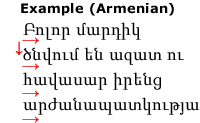 Left to right, horizontal
Left to right, horizontal
The following writing systems are written from left to right in horizontal lines:
Afaka, Ahom, Armenian, Balinese, Bassa (Vah), Beitha Kukju, Benjamin Franklin's Phonetic Alphabet, Bengali, Blackfoot, Blissymbolics, Brahmi, Buhid, Burmese, Carrier, Celtiberian, Cham, Cherokee, Chinese, Coptic, Cree, Cyrillic, Dehong Dai/Tai Le, Deseret, Devanagari, Dhives Akuru, Elbasan, Ethiopic, Fraser, Georgian (Asomtavruli), Georgian (Nuskhuri), Georgian (Mkhedruli), Glagolitic, Gothic, Grantha, Greek, Gujarati, Gurmukhi (Punjabi), Hmong, Iberian (Southern), International Phonetic Alphabet, Inuktitut, Irish Uncial, Javanese, Kannada, Kayah Li, Khitan, Khmer, Korean, Kpelle, Kulitan, Jurchen, Lanna, Lao, Latin, Lepcha, Limbu, Linear A, Linear B, Loma, Lontara/Makasar, Malachim, Malayalam, Manpuri, Mayan, Modi, Mongolian Horizontal Square Script, Naxi, Ogham, Ojibwe, Old Church Slavonic, Old Permic, Odia, Passing the River, Pitman Initial Teaching Alphabet, Pollard Miao, Quikscript/Read Alphabet, Ranjana, Redjang, Runic, Santali, Sharda, Shavian, Shorthand, Siddham, Sinhala, Solresol, Somali, Sorang Sompeng, Saurashtra, Soyombo, Sundanese, Sunuwar, Sutton SignWriting, Syloti Nagri, Tagalog, Tagbanwa, Tai Dam, Tai Lue, Tamil, Telugu, Thai, Theban, Tibetan, Tifinagh, Tikamuli, Todhri, Tocharian, Ugaritic, Vai, Varang Kshiti, Visible Speech, Yi
[top]
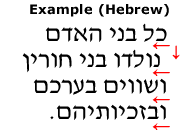 Right to left, horizontal
Right to left, horizontalThe following writing systems are written from right to left in horizontal lines:
Adlam, Ancient Berber, Ancient Egyptian (Demotic), Ancient Egyptian (Hieratic), Ancient Egyptian (Hieroglyphic), Aramaic, Arabic*, Avestan, Chinese**, Cypriot, Enochian, Etruscan, Hebrew, Iberian (Northern), Kharosthi, Linear B, Old Italic, Orkhon, Mandaic, Mende, Meroïtic (Cursive), Middle Persian, Nabataean, N'Ko, Parthian, Phoenician, Proto-Elamite, Psalter, Sabaean, Samaritan, Sogdian, Syriac, South Arabian, Thaana
*In Arabic numerals are written from left to right.
** In vertical Chinese texts the headings are sometimes written horizontally from right to left across the tops of the columns (see below). This direction is also occasionally used on shop signs.
[top]
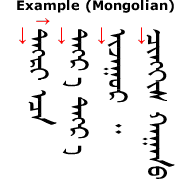 Left to right, vertical, top to bottom
Left to right, vertical, top to bottomThe following writing systems are written from left to right in vertical lines running from top to bottom:
Old Elamite, Manchu, Mongolian, Oirat Clear Script, Phags-pa, Sogdian, Sutton SignWriting, Uyghur
[top]
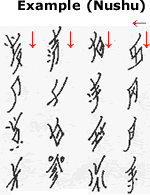 Right to left, vertical, top to bottom
Right to left, vertical, top to bottomThe following writing systems are written from right to left in vertical lines running from top to bottom:
Chinese, Chữ-nôm, Japanese, Korean, Kulitan, Meroïtic (Hieroglyphic script), Nushu, Tangut (Hsihsia)
Until the 1980s Korean was usually written from right to left in vertical columns. Since then writing from left to right in horizontal lines has become popular, and today the majority of texts are written horizontally.
Chinese is often written vertically in Taiwan, while in China and Singapore it is usually written horizontally.
Vertical and horizontal texts are both used in Japan
[top]
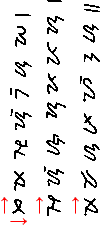 Left to right, vertical, bottom to top
Left to right, vertical, bottom to topThe following writing systems are written from left to right in vertical lines running from bottom to top:
Tagbanwa is traditionally written in vertical columns running from bottom to top and from left to right, however it is read from left to right in horizontal lines.
[top]
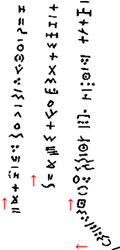 Right to left, vertical, bottom to top
Right to left, vertical, bottom to topThe Ancient Berber developed from the Phoenician script and like Phoenician, was originally written from right to left in horizontal lines, but became more commonly written from bottom to top in vertical columns running from right to left.
[top]
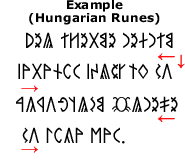 Boustrophedon
BoustrophedonThe following writing systems are written in horizontal lines running alternatively from right to left then left to right. This is called Boustrophedon, which comes from the Greek βους (bous) "ox" + στρεφειν (strefein) "to turn", because it resembles the path an ox makes when plowing field, turning at the end of each row to return in the opposite direction.
Székely-Hungarian Rovás (Hungarian Runes), Linear B, Rongo Rongo, Sabaean
[top]
The Ancient Egytian Hieroglyphic script was written in any direction the was convenient: horizontally from right to left or left to right or vertically from top to bottom. The arrangement of the glyphs was partly determined by aesthetic considerations. When written horizontally, you can tell the direction of a piece of writing by looking at the way the animals and people are facing: they look towards the beginning of the line.

Source: http://hieroglyphs.net
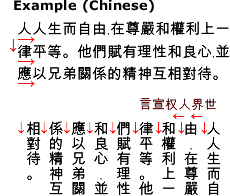 Chinese
ChineseChinese can be written from right to left in vertical columns, left to right in horizontal lines, or occasionally right to left in horizontal lines. In Taiwan it is often written vertically, while in China and Singapore it is usually written horizontally. In newspapers and magazines with vertical text, some of the headlines and titles are written horizontally right to left across the top of the main text.
Etruscan was sometimes written in boustrophedon fashion and sometimes from right to left in horizontal lines.
Japanese can be written from right to left in vertical columns or left to right in horizontal lines. Horizontal writing was first used during the Meiji Period (1868-1912) in Western language dictionaries of Japanese. Today both orientations are used.
Until the 1980s Korean was usually written from right to left in vertical columns. Since then writing from left to right in horizontal lines has become popular, and today the majority of texts are written horizontally.
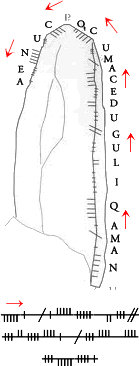
When inscribed on stones, Ogham was written around the edge starting at the bottom left and running upwards then back down the other side. In manuscripts it was written horizontally running from left to right.
Orkhon was written mainly from right to left in horizontal lines, though some inscriptions are written vertically with the letters rotated by 90º. When written vertically, it read from bottom to top and right to left.
In inscriptions, Mayan was written in paired columns zigzagging downwards from left to right. Any faces on the glyphs generally look towards the beginning of the line, as with Egyptian Hieroglyphs. Elsewhere it was usually written horizontally from left to right

From: Flickr
[top]
Writing systems: Abjads | Alphabets | Abugidas | Syllabaries | Semanto-phonetic scripts | Undeciphered scripts | Alternative scripts | Constructed scripts | Fictional scripts | Magical scripts | Index (A-Z) | Index (by direction) | Index (by language) | Index (by continent) | What is writing? | Types of writing system | Differences between writing and speech | Language and Writing Statistics | Languages
Page last modified: 13.10.24
[top]
You can support this site by Buying Me A Coffee, and if you like what you see on this page, you can use the buttons below to share it with people you know.

If you like this site and find it useful, you can support it by making a donation via PayPal or Patreon, or by contributing in other ways. Omniglot is how I make my living.
Note: all links on this site to Amazon.com, Amazon.co.uk
and Amazon.fr
are affiliate links. This means I earn a commission if you click on any of them and buy something. So by clicking on these links you can help to support this site.
[top]